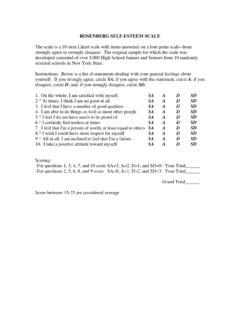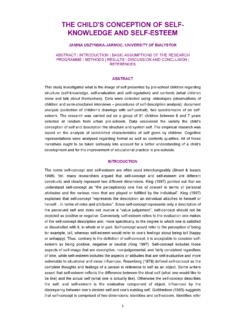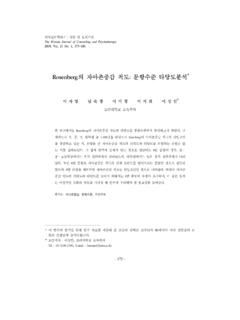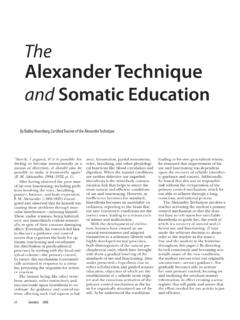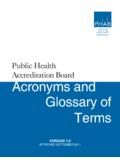Transcription of Self-Conscious Emotions June Price Tangney George Mason ...
1 Self-Conscious Emotions june Price Tangney George Mason University Jessica Tracy University of British Columbia Rev. 5/6/11 *To appear in Leary, M., & Tangney , (Eds) Handbook of self and identity. New York: Guilford Press. All human Emotions are, in a loose sense, self -relevant. Emotions arise when something self -relevant happens or is about to happen. In the language of appraisal theory (Lazarus, 1966), we experience Emotions when we judge that events have positive or negative significance for our well-being. The specific type of emotional response is shaped both by such primary appraisals of events positive vs. negative implications for the individual, and by secondary appraisals ( , of one s ability to cope with the events).
2 But all Emotions arise from events that in some way have relevance for oneself. There is, however, a special class of human Emotions that are even more immediately self -relevant. This chapter focuses on these Self-Conscious Emotions , which directly involve self -reflection and self -evaluation. Self-Conscious Emotions Shame, guilt, embarrassment, and pride are members of a family of Self-Conscious Emotions that are evoked by self -reflection and self -evaluation. This self -evaluation may be implicit or explicit, consciously experienced or transpiring beyond our awareness. But in one way or another, these Emotions fundamentally involve people s reactions to their own characteristics or behavior.
3 For example, when good things happen, we may feel a range of positive Emotions -- joy, happiness, satisfaction or contentment. But we feel pride in our own positive attributes or actions. By the same token, when bad things happen, many negative Emotions are possible for example, sadness, disappointment, frustration, or anger. But feelings of shame and guilt typically arise from the recognition of one's own negative attributes or behaviors. Even when we feel shame due to another person's behavior, that person is almost invariably someone with whom we are closely affiliated or identified ( , a family member, friend or colleague closely associated with oneself). We experience shame because that person is part of our self -definition.
4 One way to understand the distinction between Self-Conscious and non- Self-Conscious Emotions is to think about how every emotion is uniquely influenced, and in some cases dramatically shifted, by the involvement of self -processes, such as self -reflection and self -evaluation. These processes convert what would otherwise be sadness, fear, anger, disgust, and joy into the more self -relevant Emotions of shame, guilt, hostility, contempt, and pride. For example, fear can become transmuted into guilt when we think about what our fear means for our identity; this may be why Franklyn Delano Roosevelt s famous statement, The only thing we have to fear is fear itself, had a major impact on a generation of individuals who were at an age when identity concerns are highly prominent.
5 Anger becomes hostility or aggression when it is directed toward someone who has threatened an individual s identity and made him or her feel insecure (Bushman & Baumeister, 1998). Another presidential quote, You won t have Nixon to kick around anymore reflects this sentiment. Happiness becomes pride when individuals credit themselves for a positive event (Tracy & Robins, 2004). As these examples imply, Self-Conscious Emotions are a special class of Emotions that critically involve self -relevant thoughts, feelings, intentions, and behaviors (Campos, 1995; Fischer & Tangney , 1995). They drive people to work hard in achievement and task domains (Stipek, 1995; Weiner, 1985), and to behave in moral, socially appropriate ways in their social interactions and intimate relationships (Baumeister, Stillwell, & Heatherton, 1994; Leith & Baumeister, 1998).
6 As a result, Self-Conscious Emotions are important to a range of social outcomes. Guilt is centrally involved in reparative and pro-social behaviors such as empathy, altruism, and care-giving (Batson, 1987; Baumeister et al., 1994; Tangney & Dearing, 2002). Shame punishes immoral behavior, as it is felt when individuals violate (or anticipate violating) important social standards. Pride motivates pro-social behaviors (Hart & Matsuba, 2007; Tracy, Shariff, & Cheng, 2010) and is the emotion (along with shame) that gives self -esteem its affective kick (Brown & Marshall, 2001). Together, Self-Conscious Emotions function to provide immediate and salient feedback on our social and moral acceptability our worth as a human being.
7 The primary distinctive characteristic of Self-Conscious Emotions is that their elicitation requires the ability to form stable self -representations ( me ), to focus attention on those representations ( , to self -reflect; I ), and to put it all together to generate a self -evaluation (Tracy & Robins, 2004). Complex self -evaluative processes are both an important part of the direct causal processes that elicit Self-Conscious Emotions ( , a proximal cause) and of the evolutionary processes through which these Emotions became part of the human repertoire ( , a distal cause). These self -processes may mediate the relation between an emotion-eliciting event or environmental stimulus, and its emotional output (the Self-Conscious emotion).
8 Shame and Guilt To many, shame and guilt are the quintessential moral Emotions woven inextricably in our imagery of the repentant sinner. Shame and guilt are typically mentioned in the same breath, as moral Emotions that inhibit antisocial, morally objectionable behavior. But an extensive theoretical and empirical literature underscores striking differences in the phenomenology of these Emotions (Lewis, 1971; Lindsay-Hartz, 1984; Tangney , 1993; Tangney & Dearing 2002; Weiner, 1985; Wicker, Payne & Morgan, 1983) -- differences that have important and distinct implications for subsequent motivation and behavior. Most notably, a decade of research indicates that the shame and guilt are not equally moral or adaptive Emotions .
9 Evidence suggests that whereas guilt consistently motivates people in positive direction (Baumeister, et al., 1994; Eisenberg, 1986; Tangney , 1991; 1995a, b), shame is a moral emotion that can easily go awry ( Tangney , 1991, 1995a, b, 1996). What is the Difference Between Shame and Guilt? Despite the general tendency among many to use the terms shame and guilt interchangeably, a large body of research suggests that these two Emotions are in fact quite distinct. Two bases for distinguishing between shame and guilt stand out as especially influential early anthropologists focus on public vs. private transgressions ( , Benedict, 1946), and Helen Block Lewis s (1971) focus on self vs. behavior.
10 In distinguishing between shame and guilt, anthropologists focused on differences in the content or structure of events eliciting these Emotions . The notion is that certain kinds of situations lead to shame, whereas other kinds of situations lead to guilt. More specifically, shame was viewed as a more "public" emotion than guilt (Benedict, 1946), arising from public exposure and disapproval of some shortcoming or transgression. Guilt, on the other hand, was conceived as a more "private" experience arising from self -generated pangs of conscience. As it turns out, empirical research has failed to support this public/private distinction ( Tangney , Marschall, Rosenberg, Barlow & Wagner, 1994; Tangney , Miller, Flicker & Barlow, 1996).

